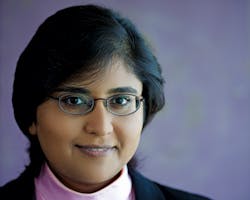NANOTECHNOLOGY/MOBILE HEALTH: Pioneering products for global priorities
Dr. Anita Goel's ultimate goal, to understand living systems, has led her on a 20-year quest to help decentralize, mobilize, and personalize medicine. Previously named by MIT Technology Review as one of the World's "Top 35 under 35 science and technology innovators," Goel, an MD and PhD, is a pioneer in the emerging field of nanobiophysics, a new convergence of physics, nanotechnology, and biomedicine—and was a featured speaker at Strategies in Biophotonics (Boston, MA; Sept. 9-11, 2014). These days, she carries out her pioneering efforts as chairman and CEO of both Nanobiosym Inc. (NBS) and Nanobiosym Diagnostics (NBSDx).
NBS is a technology incubator for fundamental research funded at various points of time with grants from agencies such as DARPA, DoD, and NSF. The institute/incubator has a three-fold mission: 1) To create new science and disruptive technologies that emerge at the convergence of physics, biomedicine, and nanotechnology; 2) to spin off new companies and joint ventures that capture the commercial impact of the promise of nanotechnology; and 3) to transition these technologies to solve pressing healthcare, energy, and environmental challenges.
By contrast, NBSDx is NBS's commercial engine, with a focus on commercialization of its diagnostic technology platform, which Goel explains "will empower people worldwide with rapid, accurate, and portable diagnostic information about their own health." Called Gene-RADAR, the chip-based platform, which is the size of an iPad, "can diagnose any disease with a genetic fingerprint"—including HIV, Ebola, tuberculosis, malaria, and drug-resistant mutations thereof, Goel told BioOptics World. As ever, early detection means the opportunity for both better containment of communicable diseases and better treatment for those infected. In a dramatic example, Goel explains how Gene-RADAR's ability to measure viral load in HIV-positive mothers and their infants will enable real-time customization of antiretroviral therapy and monitoring of treatment.
Flexible and direct
Gene-RADAR uses light to measure directly from a single drop of blood or saliva. "Unlike approaches that are based on antigens or antibodies, Gene-RADAR's approach is very simple in that it measures directly. There is no hybridization involved; instead, it is based on actual direct detection," Goel explains. And it requires no lab infrastructure, no running water or constant electricity, and no trained healthcare staff, so it has potentially dramatic humanitarian impact in areas and situations previously inaccessible to high tech. In 2013, Nanobiosym was awarded the grand prize at the Nokia Sensing XCHALLENGE for Gene-RADAR's advanced sensing technology.
Goel credits tools based on optics and quantum optics—for instance, optical tweezers and atomic force microscopes—for enabling study at the single-molecule level and for facilitating exploration of the dynamics of enzymes such as polymerases that operate as they read and write DNA. Such research, she says, has provided unprecedented insight into these structures' context-dependent function—insight that has become foundational for NBSDx.
Gene-RADAR is based upon findings that these enzymes (which Goel says can be viewed as nanoscale bio-motors able to convert chemical energy stored in nucleotides into mechanical work) serve to replicate, transcribe, or otherwise process biological information.1 Precision control of these "molecular engines" has broad implications for biomedicine (including whole-genome sequencing with ultra-high precision and accuracy, and molecular manufacturing of biopolymers) and beyond (for instance, biological computation and information storage).2
The global health impact of inexpensive mobile technologies such as Gene-RADAR was the focus of Goel's presentation at Strategies in Biophotonics. Her talk followed the opening keynote by lauded engineer and entrepreneur Robert Langer of MIT. For more on the event, see www.strategiesinbiophotonics.com.
ACKNOWLEDGEMENT
Gene-RADAR is a registered trademark of Nanobiosym Diagnostics.
REFERENCES
1. A. Goel and V. Vogel, Nature Nanotechnol., 3, 465–475 (2008); doi:10.1038/nnano.2008.190.
2. A. Goel, Sci. Am. India, 5, 12, 53–57 (2010).

Barbara Gefvert | Editor-in-Chief, BioOptics World (2008-2020)
Barbara G. Gefvert has been a science and technology editor and writer since 1987, and served as editor in chief on multiple publications, including Sensors magazine for nearly a decade.
